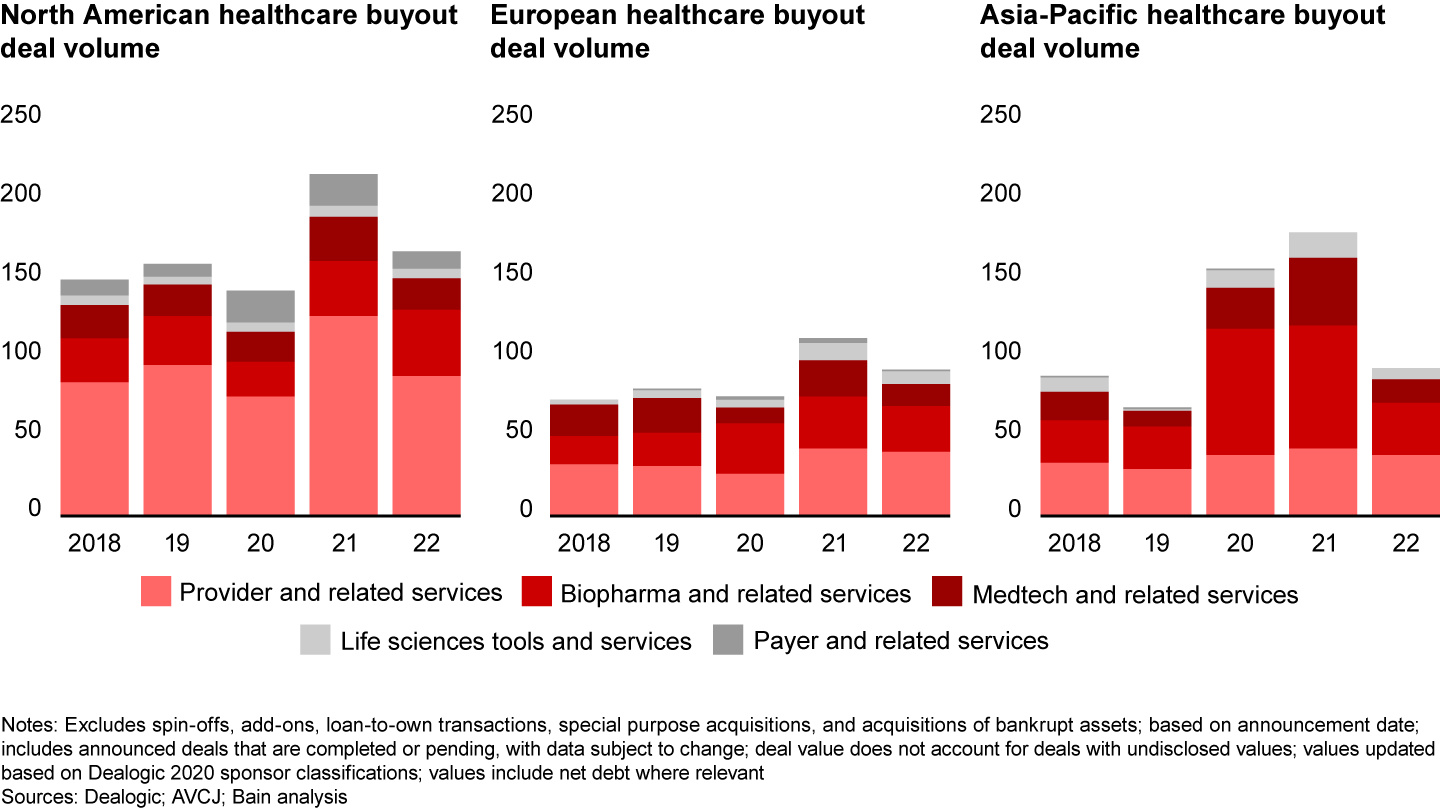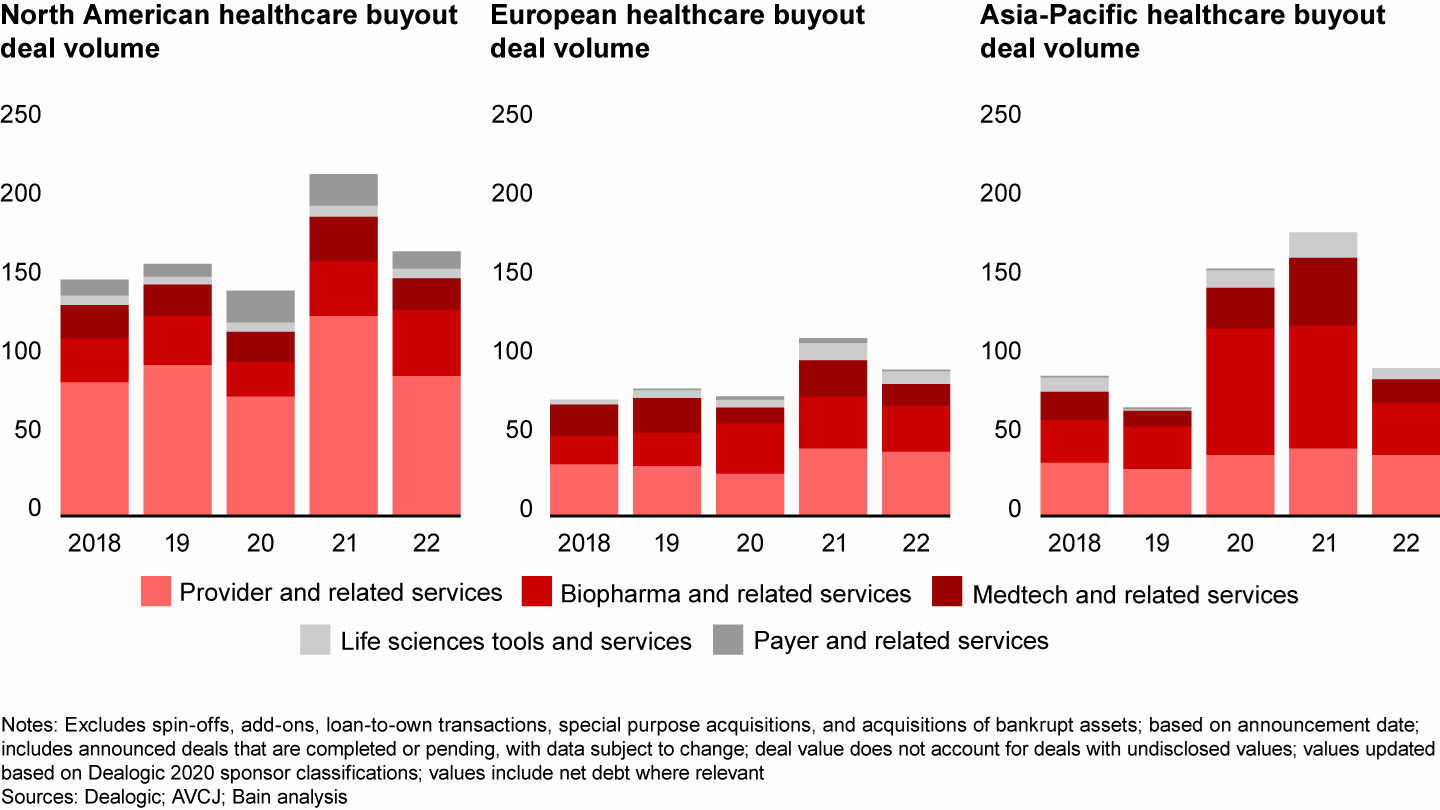Global Healthcare Private Equity Report

At a Glance
- Provider deals made up nearly half of deal volume and value in 2022, despite the downward trajectory in activity throughout the year.
- Global deal flow underscored new specialty physician practice management opportunities.
- Deal activity varied by geography. In the US, targeted value-based care drove buyouts; in Europe, retail health continued to propel activity; and in the Asia-Pacific region, the growth of hospital platforms continued.
- Service businesses that enable providers to “do more with less” drew activity.
This article is part of Bain's 2023 Global Healthcare Private Equity and M&A Report.
Deal activity in 2022 saw a reversion to the mean following 2021’s record highs, with provider-related deals accounting for 47% of healthcare buyout activity. 2022 began with a bang, with first-quarter activity almost on par with the first quarter of 2021. Volume, though, declined steeply starting in the second quarter, and the slowdown persisted throughout the year, with fourth-quarter deals roughly half that of the previous two quarters (see Figure 1). Despite the sudden contraction and persistent labor concerns, provider activity in 2022 was the second highest in the past decade, with care delivery assets such as hospitals, ambulatory surgery centers, and physician offices accounting for more than half of all provider-related buyouts.


North America accounted for 53% of deal activity, defining many trends within the provider subsector, but was down 30% in terms of volume compared with 2021. Europe posed specific challenges both in terms of significant post-Covid pressures on the sector that were exacerbated by self-inflicted difficulties (such as Brexit in the UK) and avoided or delayed, but long overdue, reforms in markets such as Germany and France. Despite these challenges, deal volume in Europe was down just 5% compared with 2021, with 40 deals. Asia-Pacific was resilient as well, with 38 deals compared with 42 in 2021, driven by the continued trend toward high-quality, specialized care.
Continued focus on physician practice management models
Tailwinds from ancillary opportunities and the resilience of buy-and-build models led to continued physician practice management (PPM) investment. This varied across and within geographies.
North America: Established specialties such as dermatology, ophthalmology, and gastroenterology attracted strong buyout activity. Concurrently, investment in specialty dental and cardiology rose.
In dermatology, Partners Group acquired Forefront Dermatology for $1.5 billion. In gastroenterology, Apollo Global Management facilitated a physician-led buyout of GI Alliance via its $785 million noncontrolling investment. There were notable exits as well, with Shore Capital exiting EyeSouth Partners to Olympus Partners after a five-year buy-and-build strategy that grew the ophthalmology chain from 12 practitioners to 270. In specialty dental, InTandem Capital Partners exited Paradigm Oral Health to BlackRock for more than $900 million and Thomas H. Lee Partners invested in Smile Doctors, joining Linden Capital Partners as a shareholder. Lastly, in cardiology, Webster Equity Partners’ Cardiovascular Associates of America platform continued to expand, partnering with Southwest Cardiovascular Associates.
Europe: Investors focused on specialties such as women’s health, ophthalmology, and radiology. Individual European localities moved at different speeds, with the exception of France, where fast-paced consolidation in veterinary, radiology, and dental has begun. In Europe, asset-light retail health chains are gradually emerging, and a new breed of chains that focus on operational efficiency as a value driver rather than self-pay will begin to take hold.
In women’s health, Nordic Capital acquired CARE Fertility and KKR bought IVIRMA Global for $3.2 billion. In ophthalmology, Groupe Bruxelles Lambert (GBL) acquired a majority stake in Sanoptis, the second-largest ophthalmology services provider in Europe, with more than 250 facilities. GBL also acquired a majority stake in Affidea, a radiology provider, from B-FLEXION (formerly known as Waypoint Capital) for $1.7 billion. Also in radiology was EQT’s joint acquisition of Meine Radiologie and Blikk, which EQT consolidated with Aleris to form evidia.
Asia-Pacific: Investors backed single and multispecialty providers given the large demand-supply mismatch for care. Other potential trends that bear watching include activity in residential care centers and veterinary medical practices.
Adamantem Capital carved out GenesisCare’s cardiology business. In women’s health, Kedaara Capital invested in Sadguru Healthcare Services’ Oasis Fertility unit. Furthermore, there were a number of notable multispecialty provider deals. TPG exited India-based hospital operator Manipal Health as part of a transaction valuing the business at $2.1 billion. There were club investments in Max Healthcare for $1.2 billion and IMU Healthcare. Lastly, Everstone Group partially exited Sahyadri Hospitals to the Ontario Teachers' Pension Plan Board.
Enabling more tailored care delivery
Particularly in the US, care management aimed at specific populations gained momentum in 2022, accelerated by delivery model innovation, regulatory changes, payers’ cost-containment efforts, and consumers’ desire for convenience. This shift is exemplified in two areas:
Complex care populations
Specialty services such as home care, specialty pharma, and ambulatory infusion service providers continued to attract considerable interest in the US in 2022. Clayton Dubilier & Rice’s acquisition of a majority stake in Gentiva Certified Healthcare for $2.8 billion underscores the effort to provide care closer to home. There were also two home health-related deals in Asia-Pacific potentially foreshadowing growth in other markets.
Within the specialty pharma space, there were two standouts focused on rare diseases, (1) Nautic Partners, the Vistria Group, and General Atlantic’s acquisition of PANTHERx Rare, and (2) the Carlyle Group’s investment alongside existing owner Consonance Capital, which rolled its equity, in Orsini Specialty Pharmacy.
Buyout activity within the infusion therapy space accelerated. Novo Holdings acquired KabaFusion, Ridgemont Equity Partners acquired American Outcomes Management, and InTandem Capital Partners merged two companies to form Vivo Infusion. While the business models vary, these deals demonstrate the increasing focus on specialty infusion and expansion of ambulatory care models.
Behavioral health services
We saw continued buyout activity in behavioral health, including age-specific services assets. Within children’s behavioral health, KKR led a growth equity investment in Brightline, which provides virtual behavioral health services tailored to children and their families. Reflecting interest in the autism space, Charlesbank Capital Partners acquired Action Behavior Centers, an ABA therapy provider for children with autism, for a reported $840 million. On the other end of the age spectrum, Webster Equity Partners invested in Oceans Healthcare, which builds on its roots in geriatric behavioral health to provide both inpatient and outpatient care.
There are strong macro tailwinds behind investments in many pockets of behavioral health, most notably the supply gap and strong demand for behavioral health services. However, increasing valuations for behavioral health assets make buy-and-build plays more difficult, while labor shortages and the wage rate trend pose execution challenges. Investors should enter this space with eyes wide open, particularly in this macro context.
Resource optimization takes center stage
Given tight labor markets, service businesses that enable providers to “do more with less” maintained momentum. While much of the attention has been on healthcare information technology (HCIT) assets (see the chapters “Provider Information Technology: Mind the Gap” and “Healthcare IT: Two Very Different Half Years”), two other services also benefited from this focus: labor force management and revenue cycle management solutions.
Labor force management
Coming out of Covid, labor shortages fueled investments in traditional and innovative workforce management solutions. This was most notable in North America, where private equity sponsors played this trend from multiple angles, including locum tenens (such as H.I.G. Capital’s acquisition of Barton & Associates), staffing outsourcing (The Pritzker Organization’s acquisition of Epic Staffing Group), and travel nursing (One Equity Partners’ acquisition of Prime Time Healthcare).
Revenue cycle management
Providers continue to outsource core revenue cycle functions to improve collections and cost savings. While this theme emerged across provider healthcare IT buyouts, it also holds for provider services. Notable deals in the revenue cycle management (RCM) services space include Berkshire Partners and Warburg Pincus’s joint acquisition of Ensemble Health Partners and Veritas Capital’s acquisition and subsequent merger of Coronis Health and MiraMed Global Services. Furthermore, at the end of 2021, Welsh, Carson, Anderson & Stowe brought together EnableComp and Argos Health, a revenue cycle platform specializing in the management and resolution of complex claims.
New models on the horizon
Despite headwinds from labor supply and inflation, we expect provider deal activity to remain a significant proportion of healthcare deals. Investors will continue to look for creative ways to compete within the subsector, for example placing bets within value-based care, investing in targeted care delivery models, and expanding next-gen PPMs to additional specialties.
In the US, next-generation primary care models like Oak Street Health continue to attract attention. As payers and providers become increasingly comfortable with value-based models, we expect to see continued investment in risk-bearing models across specialties beyond primary care and in segments beyond Medicare. Medicaid and commercial payers are earlier in their value-based care journey. In the past few years, we have seen companies like Cityblock Health and Vera Whole Health (which combined with Castlight in 2022) attract significant investment to expand value-based care to Medicaid and commercial populations. Serving Medicare, Medicaid, and commercial populations requires different models given differences in reimbursement rates and patient demographics. Opportunities exist for investors that can partner with organizations on the forefront of this shift to value (see the chapter “Value-Based Care: Opportunities Expand”).
In Europe, with several geographies catching up while others define new models beyond buy-and-build-driven consolidation, the retail health landscape has matured significantly. It now requires new investors to focus their value creation plans on realizing operational efficiencies and bringing the benefits of working in larger networks and of digitalization to their stakeholders.
Globally, provider IT and services businesses that support resource optimization and improve care delivery will continue to gain traction, both in the current macroeconomic climate and beyond. Wages in healthcare have increased faster than reimbursement rates. According to an analysis of data from Peterson-KFF, healthcare sector average weekly wages increased by 3.7% from January 2022 to November 2022, while the producer price index (PPI) for health services—which includes medical services paid for by commercial and government payers—increased only by 1.7%. Additionally, recent discussions in Washington about Medicare cuts continue raising concerns and generating pushback from providers and Medicare Advantage plans alike. While wage increases vary by setting and reimbursement rates vary by payer, providers will continue to focus on solutions that help improve profitability in the current environment.